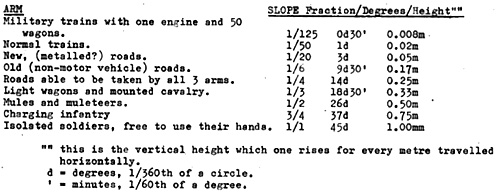When I was browsing around the military science books in the library I came across an old French military publication, Almenech du Drapeau for the years 1900-1905. Among most interesting articles, including illustrations and histories of the Ancien Regime flags for Infantry, artillery and Cavalry, there are the useful 'Connaisances Militaires' including one about the practicability of slopes.
A ARMY ON THE MARCH

This is the vertical height which one rises for every metre travelled horizontally.
d - degrees, 1/360th of a circle.
' - minutes, 1/60th of a degree.
These are supposed to be the maximum limits to which the French army was willing to go, but one is not sure whether they are underestimating or overestimating their, case for the sake of security or propaganda respectively. They are useful guidelines for those with handy maps in preventing one from drawing in a road where it is obvious a goat would have trouble climbing, or similar absurd mistakes which I and no doubt a few others have found out when tempted to transfer our fictional maps into table-top reality. Common sense study of the contours of ones maps may then prevent one from say finding that your Sioux war party has fled into a dead-end canyon with sides too steep to clamber out of which in real-life it is doubtful that they would do that is presuming they are on known, home territory.
B VISIBILITY TABLE
Another useful snippet was a list of the visibility of certain objects at varying distances, by a man with normal sight.
- At 15km Church bell-towers.
At 10km Windmills, towers and chateaux.
At 4km Chimneys and windows of houses.
At 2km 500 big tree trunks.
At 1km Telegraph poles.
At 1500m A black unbroken line; infantry. A black line, its upper half notched: cavalry.
At 1200m The number of files of infantry, the number of artillery pieces and their teams, and if the troopers are mounted or dismounted.
At 800m The arm and leg movements of soldiers.
At 600m The number of files that make up a unit.
At 450m The heads of individual men and the shape of their "headdresses".
At 300m Shiny ornaments and the ornaments on a flag.
The foresight of a rifle covers at 500m the whole soldier. At 400m the shoulders of the soldier. At 200m the waist of the soldier.
C FORDING
The depth of fording was also given.
- Infantryman: from 80cm to 1m.
Cavalrymen: around 1m. 20cm.
Wagons: 60cm without wetting freight; 1m 30cm and wetting its freight.
D The Safe Thickness of Ice
For various loads.
- 4cm - a single man, marching "sur des madriers" (translation?)
9cm - men in spaced-out files.
12cm - cavalry.
14cm - campaign artillery, manhandled.
16cm - campaign artillery, horse-drawn.
27cm - very heavy loads.
That is just a few of the things I managed to scavenge, using my elementary French and the help of a pocket dictionary. Other tidbits include contemporary accounts of the Boer War, French army organisation, strength, armament, distribution, etc., organisation and uniforms of the 1905 Russo-Japanese War and so on.
The parts I have selected will clarify some of those areas where information, being out of the ordinary, is hard to get. Much could be fitted into wargame campaigns, battlefield reconnaisance, and so on.
Back to Table of Contents -- Wargamer's Newsletter #143
To Wargamer's Newsletter List of Issues
To MagWeb Master Magazine List
© Copyright 1974 by Donald Featherstone.
This article appears in MagWeb (Magazine Web) on the Internet World Wide Web.
Other military history articles and gaming articles are available at http://www.magweb.com